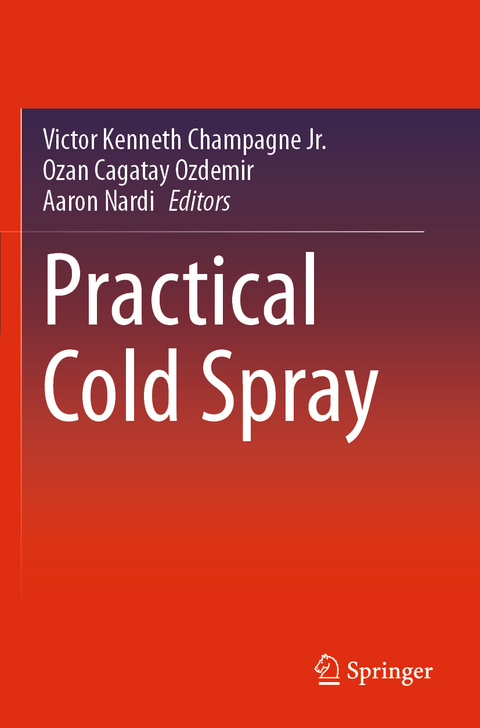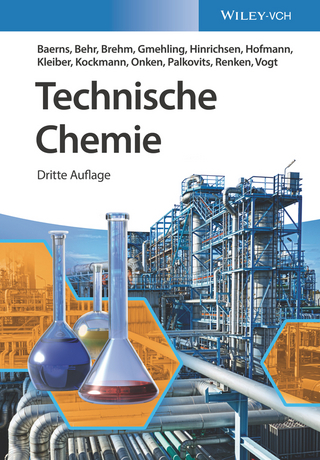
Practical Cold Spray
Springer International Publishing (Verlag)
978-3-030-70058-4 (ISBN)
This book provides a detailed explanation of the cold spray process from a practical standpoint. Drawing on the authors' 36 years of research and development experience, it is firmly rooted in theory but also substantiated by empirical data and practical knowledge, offering potential users the information they need to recognize the advantages, as well as the limitations, of cold spray. This sets it apart from previous works on the subject, which have been purely academic.
Cold spray technology has made great dramatic strides over the last 10 years and is now being used extensively in the aerospace, electronics, automotive, medical, and even the petrochemical industries. Most recently, cold spray of near-net shaped parts was accomplished - something previously assumed to be impossible because of the limitations of commercially available cold spray systems and a lack of fundamental understanding regarding the process. The cost of cold spray has also declined, making it appealingto industry through the introduction of new powders, surface preparation techniques, and recovery systems tailored to the cold spray process.Though primarily intended for users of the technology, this handbook is also a valuable resource for researchers interested in advances in cold spray materials, improved feedstock powders, advanced hardware and software development, surface preparation techniques, and the numerous applications developed to date. For example, cold spray aluminum alloys have been developed that offer the strength and ductility of wrought material in the as-sprayed condition. This has yet to be achieved by conventional powder consolidation methods including laser sintering, electron beam, and ultrasonic techniques. Other topics covered include additive manufacturing, structural repair, nondestructive evaluation, advanced cold spray materials, qualification requirements, cold spray systems comparison, and, finally, helium recovery. Thanks to its practical focus, the book provides readers with everything they need to understand, evaluate, and implement cold spray technology.Dr. Champagne is recognized internationally as one of the foremost authorities on Cold Spray and has held numerous positions throughout a 37 year career, conducting high impact materials research in collaboration with dozens of universities, national laboratories and industry, on an international level. Dr. Champagne founded and has served as lead of the ARL Cold Spray Center for over twenty years, conducting research & creating an 'eco- system' in Cold Spray, advancing it from basic research into a robust Additive Manufacturing technology, and transitioning it across the Army, DoD and numerous industrial sectors, through visionary strategy and aggressive pursuit of resources. His research has been recognized at the highest levels, nationally and internationally. As an advocate of the environment, Dr. Champagne has helped to lower hazardous waste and other pollutants associated with materials and manufacturing processes. In 1998, his achievements for environmental research were honored by President Clinton with the Closing the Circle award. In 2007 and 2009, he received the US Army R&D Achievement Award at the Pentagon. Dr. Champagne has also received the Defense Manufacturing Achievement Award in 2007 for Cold Spray and a Cold Spray Industry Achievement Award at the North American Cold Spray Conference in October 2011. He has won numerous 'Program of the Year' awards including; the Environmental Security Technology Program in 2012, the Defense Manufacturing Program in 2013 and 2020 for the transition of Cold Spray and the Strategic Environmental Research and Development Program in 2020 for Cold Spray powder development and commercialization. Dr. Champagne was made an ASM Fellow in 2015. Recently, he was awarded a commendation for establishing the ARL Northeast satellite for the transition of Cold Spray technology and was awarded the 2020 ASM Engineering Achievement Award for the development of a patented and commercialized Cold Spray Helium Recovery System. He is known throughout DOD and the private sector, as someone who 'gets things done', working diligently to transition emerging technologies throughout the defense industry. Dr. OEzdemir is an academic with a background in metal additive manufacturing, compressible flows, multiphase flows, heat and mass transfer, thermodynamics, and failure analysis. He received his Ph.D. in Mechanical Engineering from South Dakota School of Mines and Technology in 2017. His doctoral dissertation focused on the design and efficiency of powder propulsion systems in the emerging cold spray metal additive manufacturing technology. During his prior studies at South Dakota State University, he supported academia and industry in failure analysis through a variety of destructive and nondestructive testing methods. Dr. OEzdemir is currently leveraging his experience in multidisciplinary fields for the advancement of the cold spray technology as a research assistant professor at the Department of Mechanical and Industrial Engineering at Northeastern University in Boston. His independent and collaborative work has been high yield and has resulted in the publication of twelve journal articles in a short period of time with over 200 citations, a patent, and ten appearances in international conferences. Furthermore, Dr. OEzdemir is a proactive member of the scientific community. He is serving as a member of the Training Subcommittee of ASM International's Thermal Spray Society and he is also among other experts co-editing the proceedings of the 2021 International Thermal Spray Conference. Aaron Nardi is currently the Chief Technology Officer for VRC Metal Systems, and a well-respected technical lead for cold spray internationally. In his role at VRC, Aaron is responsible for technology leadership within the organization and identification of emerging trends in cold spray. Prior to VRC Aaron was the team lead for the Solid-State Additive Manufacturing Team within the Weapons and Materials Division of the US Army Research Labs. In this role he had technical leadership for all activities underway within the lab including operations at Aberdeen Proving Grounds, at facilities which are part of ARL Northeast, and at partner laboratories within academic and industrial collaborator sites. Prior to ARL Aaron was the team lead for the United Technologies Research Center Cold Spray facility working in close collaboration with the US Army Research Labs. Aaron was responsible for creating this new capability for UTC in 2010 and quickly grew it into a leading research facility for Cold Spray process and materials development worldwide. Aaron's work in Cold Spray not only led to significant advancements in material properties but also resulted in key material and hardware patents some of which were later licensed to suppliers in the industry. Aaron began his career in 1996 as a mechanical metallurgist with Hamilton Standard, a division of UTC, with a focus on fatigue, fracture mechanics, and tribology. He took on increasingly important roles eventually being the lead for the mechanical behavior labs at the corporate research labs, UTRC, prior to his career in cold spray technology. Aaron Nardi has a MS in Mechanical Metallurgy from Rennslear Polytechnic Institute and a BS in Mechanical Engineering and Materials Sciences from the University of Connecticut, with professional training in Fracture Mechanics and Tribology through UTC, Georgia Tech, and MIT. Aaron has 48 patents held by United Technologies, Hamilton Sundstrand, Sikorsky Aircraft, Delevan Inc., and the Otis Elevator Company in one or more jurisdictions including US, EP, WO, GB, AU, CN, ES, and JP. These patents relate to Cold Spray, advanced manufacturing processes, erosion protection, wear resistant coatings development and applications, and coating structures for fatigue mitigation. Aaron has presented at ASTM, ASM Aeromat, HCAT, CSAT, and North American Cold Spray conferences for work in crack growth, coatings evaluations, and additive manufacturing. He has technical papers in topics including Cold Spray, Thermal Spray, Additive Manufacturing, Crack Growth, and design optimization.
1.Introduction to Cold Spray.- 2. Process Description.- 3. Setting Up a Cold Spray Facility; D. Helfritch et al.- 4. Feedstock Powders.- 5. Material Properties.- 6. How to Develop and Qualify a Cold Spray System.- 7. Cold Spray Process Control and Specifications.- 8. Cold Spray Economics.- 9. Advancements in Cold Spray.- 10. Applications.
| Erscheinungsdatum | 22.06.2022 |
|---|---|
| Zusatzinfo | VIII, 441 p. 274 illus., 218 illus. in color. |
| Verlagsort | Cham |
| Sprache | englisch |
| Maße | 155 x 235 mm |
| Gewicht | 688 g |
| Themenwelt | Naturwissenschaften ► Chemie ► Technische Chemie |
| Technik ► Maschinenbau | |
| Schlagworte | Additive Manufacturing • Advanced Coatings • Aerospace Repair Materials • Cold Spray Data • Cold Spray Practical Guide • Cold Spray Technology • Commercial Cold Spray Systems • powder consolidation • thermal spray technology |
| ISBN-10 | 3-030-70058-5 / 3030700585 |
| ISBN-13 | 978-3-030-70058-4 / 9783030700584 |
| Zustand | Neuware |
| Informationen gemäß Produktsicherheitsverordnung (GPSR) | |
| Haben Sie eine Frage zum Produkt? |
aus dem Bereich


